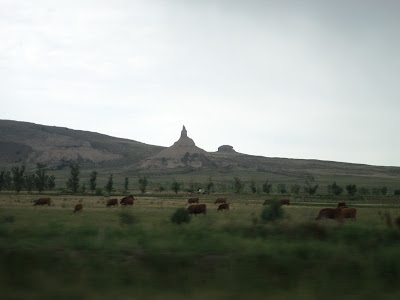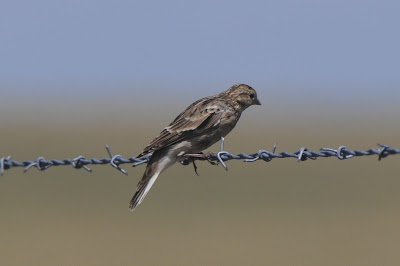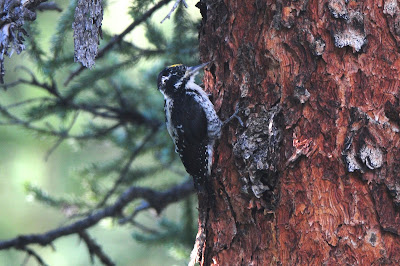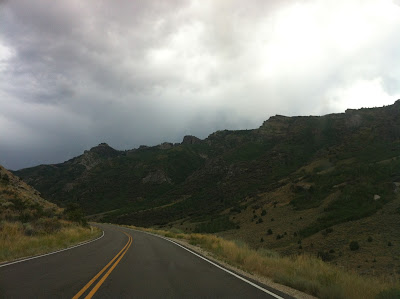I found myself staying in western Colorado after my whirlwind trip through Utah. I was keen to find some more year birds since I was passing through new territory for the year. I still needed things like Pinyon Jay, White-tailed Ptarmigan, Brown-capped Rosy-Finch, any of the prairie longspurs, prairie-chickens, etc.
Before I left the hotel, I happened to use my new BirdsEye app on my phone that displays new year birds that have been seen nearby (by gleaning eBird records). Sure enough, there was a pin for Pinyon Jay just down the road. I figured I'd give it 30 minutes before zooming up into the mountains. As I drove up, I realized why there were pins there... it looked like GREAT habitat... but no jays. I stopped here and there and saw things like BLUE-GRAY GNATCATCHER and MOUNTAIN BLUEBIRD but never any jays. At the top I turned around and headed back down. "AHH!" I saw a jay! I pulled over, put my bins on it and, ta-dah... oh.. wait... it's a WESTERN SCRUB-JAY. That's just cruel. Grumbling by this point, I continued on my way. I stopped again to look over some birds (robins, this time) but this time I thought I HEARD a Pinyon Jay. Was I making it up? Nope, I heard it again. Within a couple of seconds, a very rewarding flock of PINYON JAYS flew directly over my car, calling the entire time:
Well, that was lucky! Another target down. Now it was time to zoom up into Rocky Mountain National Park for more targets.
At nearly 12,000 feet high, my first and main stop was at the Medicine Bow corner, THE reliable spot for WHITE-TAILED PTARMIGAN. The scenery was NOT bad:

I huffed/puffed/wheezed around on the high-altitude tundra for a good while before finally finding a distant ptarmigan and three chicks up on the slope. Here's the adult:
You'll notice it's wearing a radio-transmitter (a collar). It was pretty cool to see that especially since I didn't know that they were being studied there.
I enjoyed the butterflies up there too and managed to snag a couple of lifers. First up, the COLORADO ALPINE:
The Pawnee National Grassland is surely some of the neatest prairie I can think of. I first visited them back in June, 2000 when I was attending the ABA Youth Birding Conference. Back then, we all saw both McCown's and Chestnut-collared longspurs here without trouble (I also found a McCown's Longspur nest that day; people were impressed with my nest-finding skills... I didn't tell them that I nearly stepped on the thing and it took no skill whatsoever). Anyway, let's just say I was brainwashed into thinking it would be easy for me to repeat that again... in the heat of August. Here's a view of some of the dry, short-grass prairie:

When I arrived, my new-for-the-year LARK BUNTINGS were waiting for me... everywhere. I ended up seeing 500+ that afternoon:
It was after I started walking around in some of the shortgrass prairie in the blazing afternoon heat that I started to have some concerns. I knew McCown's should be findable but Chestnut-collared is much less common there and I didn't have any reliable spot for those down the road. I needed BOTH, plain and simple. Maybe it was my audible grumblings or kicking at cow crap that did it... a bird flushed in front of me and gave some unworldly call notes (ok, compared to the longspurs I grew up with). I had a hunch and... yep, it was the first of many MCCOWN'S LONGSPURS. Check out the tail pattern the chestnut in the wings:

I continued to flush longspurs (which is good fun) but I wasn't finding the rarer Chestnut-collared yet. More longspurs got up. More McCown's. This time, some birds had pretty funky tail molt going on. Here's the new-to-science "Fork-tailed Longspur":

You know how sneaky longspurs can be; you think there's nothing in front of you but bare ground, maybe some Prickly Pear, some grasses, and maybe a clump of... "what the deuce... the bird flushed from 2 feet in front of me? How the hell did I NOT see that thing?!" Anyway, it took a while before I was able to spot any birds on the ground. Would THIS be my target bird?
Clean gray nape, dark bill, broad eyeline... as you can see, no, it's another McCown's. It was getting late and I needed to get on the road. In a very bad mood, I decided to ditch Colorado and head for western Nebraska. Chestnut-collared Longspurs also breed in South Dakota and Nebraska so I'd try my luck elsewhere. But first, I need sleep...
-ZZzzzzzzz-
The next day provided the new start I needed. It was time to drive through my old haunts of western Nebraska. I passed Chimney Rock. Fire up the archaic computer, wait 30 minutes for it to boot up, stick in the 5.25" floppy disc... it's time to play Oregon Trail!

Actually, no, I was headed for Sioux County. I had seen Chestnut-collared Longspurs there on several occasions but that was in April... not August. Before I could get to the longspur spots, I noticed an all-too-familiar bird jump off of a shoulder. I turned around. YES, it was my new-for-the-year UPLAND SANDPIPER. I had started to get worried because multiple people told me I wasn't going to find them. This photo is dedicated to those people:
Oh no. For the first (and maybe last) time, I took a scenic picture with horses in it!
Tim Hajda mentioned a spot that he had for the longspurs. It was as good of a lead as I had. I pulled off and after about 30 seconds of walking the fence line, a CHESTNUT-COLLARED LONGSPUR flushed from my feet. THIS time the call note was right on. And THIS time I got photos of the bird on the ground and even up on a fence for a bit. Note the paler bill, streaked nape, not much of an eyeline... THIS was the bird I was after:
I was feeling better now; I had snagged two year birds that I could have easily missed. I glanced behind me back towards the car. Holy crap, some giant storms were brewing to the west! Time to get moving up to South Dakota:

Traveling east through South Dakota provided me with a few options. First, I would try for GREATER PRAIRIE-CHICKEN. Also, I was looking forward to county listing in some very new areas.
So the next morning I was at the Fort Pierre National Grasslands to try my luck with an out-of-season prairie-chicken. I spent several hours with nary a sniff of these sometimes-secretive chickens. However, now that I had gotten UPLAND SANDPIPER and CHESTNUT-COLLARED LONGSPURS out of the way the day before, I found more of both of those species. Here's a longspur:
I had started seeing some eastern species by now including this adult and young EASTERN KINGBIRD. "But mommmm.... how do I CATCH these things? They're too FAST for me. DANG...."
Now it really was time for me to make up some ground. I'd worry about the prairie-chicken later. But first, I needed to drive through MN and WI to get up to Michigan.
Hmm... but why not pull off the interstate in Minnesota to grab a year bird? The BirdsEye app showed there was one. Exactly. Here's a CLAY-COLORED SPARROW about 100 ft. from I-35:
More troubling year-bird issues were creeping into my mind. I actually needed GOLDEN-WINGED WARBLER and EASTERN WHIP-POOR-WILL this year. I knew that I was NOT going to get those at Whitefish Point... and that I wasn't leaving Michigan until November. I needed to find these birds... and quickly. I used my trusty BirdsEye app again; it showed several GWWA pins in northeast Wisconsin. A quick detour, several hours of looking, and alas, a last-minute year-bird grab... a GOLDEN-WINGED WARBLER:
Due to the kindness of some local birders, I was able to find a couple of EASTERN WHIP-POOR-WILLS that night too. I couldn't have been more appreciative to them for essentially finding these year birds for me (they too use eBird, I glean eBird... you get the idea).
Off to Whitefish Point I went. I would be counting waterbirds that next morning (and many mornings thereafter). My next post will probably have Lake Superior and some Jack Pines involved. Stay tuned...













































